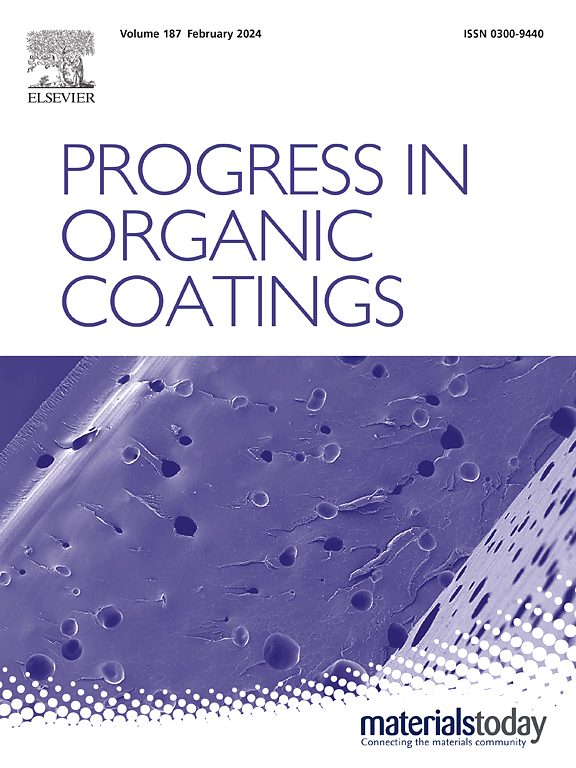Exploring the utilities of rice straw black liquor (part XI): Enhancing the UV resistance, color, antimicrobial, and mechanical characteristics of epoxy coatings using lignin-based hybrid nano-pigments
IF 6.5
2区 材料科学
Q1 CHEMISTRY, APPLIED
引用次数: 0
Abstract
The key purpose of this work is to prepare multifunctional colored coatings with good UV resistance and antimicrobial activity by incorporating lignin complex nanoparticles as hybrid nano-pigments. Firstly, four complexes [e.g., zinc (lignin/silica/fatty acids), calcium (lignin/silica/fatty acids), aluminum (lignin/silica/fatty acids), and copper (lignin/silica/fatty acids)] were synthesized on a nanoscale utilizing rice straw pulping black liquor. Then, epoxy was reinforced with 1, 2, and 4% of each of the four complexes, and their visual inspection and their mechanical properties were investigated. The findings demonstrate that four paint films of 2% Zn (LSF)-epoxy, 2% Ca (LSF)-epoxy, 2% Al (LSF)-epoxy, and 2% Cu (LSF)-epoxy are the optimum films due to their surface being homogenous and uniform without agglomeration or voids. The coatings in group II were subjected to 100 h of continuous UV irradiation, and the changes caused were determined by FT-IR, SEM, and CIE Lab (color) techniques. The results reveal that there is no significant difference between the coatings before and after the UV irradiation. In the case of specimens containing only epoxy, a significant change was observed. These results confirm that the integration of the hybrid nano-pigments has improved the UV resistance of epoxy coatings. Besides, the results showed that Zn (LSF)-epoxy, Ca (LSF)-epoxy, and Cu (LSF)-epoxy coatings have good antimicrobial activity.
探索稻草黑液的用途(第十一部分):使用木质素基混合纳米颜料增强环氧涂料的抗紫外线性能、色彩、抗菌性和机械特性
这项工作的主要目的是通过加入木质素复合物纳米粒子作为混合纳米颜料,制备具有良好抗紫外线和抗菌活性的多功能彩色涂料。首先,利用稻草打浆黑液在纳米尺度上合成了四种复合物[如锌(木质素/二氧化硅/脂肪酸)、钙(木质素/二氧化硅/脂肪酸)、铝(木质素/二氧化硅/脂肪酸)和铜(木质素/二氧化硅/脂肪酸)]。然后,分别用 1%、2% 和 4% 的四种复合物增强环氧树脂,并对其外观和机械性能进行了研究。研究结果表明,2% Zn(LSF)-环氧树脂、2% Ca(LSF)-环氧树脂、2% Al(LSF)-环氧树脂和 2%Cu(LSF)-环氧树脂四种漆膜的表面均匀一致,没有结块或空隙,是最佳漆膜。对第二组涂层进行 100 小时的连续紫外线照射,并通过傅立叶变换红外光谱、扫描电镜和 CIE Lab(色彩)技术测定所引起的变化。结果显示,紫外线照射前后的涂层没有明显差异。在仅含有环氧树脂的试样中,观察到了明显的变化。这些结果证实,混合纳米颜料的加入提高了环氧涂层的抗紫外线性能。此外,研究结果表明,锌(LSF)-环氧树脂、钙(LSF)-环氧树脂和铜(LSF)-环氧树脂涂层具有良好的抗菌活性。
本文章由计算机程序翻译,如有差异,请以英文原文为准。
求助全文
约1分钟内获得全文
求助全文
来源期刊

Progress in Organic Coatings
工程技术-材料科学:膜
CiteScore
11.40
自引率
15.20%
发文量
577
审稿时长
48 days
期刊介绍:
The aim of this international journal is to analyse and publicise the progress and current state of knowledge in the field of organic coatings and related materials. The Editors and the Editorial Board members will solicit both review and research papers from academic and industrial scientists who are actively engaged in research and development or, in the case of review papers, have extensive experience in the subject to be reviewed. Unsolicited manuscripts will be accepted if they meet the journal''s requirements. The journal publishes papers dealing with such subjects as:
• Chemical, physical and technological properties of organic coatings and related materials
• Problems and methods of preparation, manufacture and application of these materials
• Performance, testing and analysis.
 求助内容:
求助内容: 应助结果提醒方式:
应助结果提醒方式:


